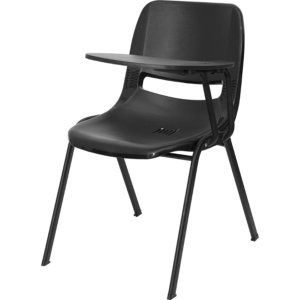By: Patricia Crocker, OTR/L, M.ED
As a child, I was appalled when my Grandmother told me that her teachers used to hit her left hand when she tried to write with her left hand. My Grandmother referred to herself as a “Southpaw”. The term “southpaw” is a slang term that refers to a person who is left-handed. The term is believed to have originated from the sport of baseball, “Traditionally, baseball fields were oriented so that the batter, catcher, and umpire faced east to ensure that the setting sun wasn’t in their eyes. As a result, when a pitcher is on the mound facing home plate, his left hand pointed south, so lefty pitchers came to be known as southpaws. “(1). In baseball as well as other sports like boxing, left-handed athletes are perceived as having an advantage. Southpaws (left-handed people) make up about 10% of the population. Because there are so few left-handed people most athletes have had less practice and exposure competing against them.
Throughout time, Left-handed people have been viewed with suspicion, fear, and were even persecuted. The word “sinister” even derives from “left or left-hand.” (2). Left-handedness has also been associated with “uncleanliness” (3), witchcraft, and even Satan himself. “Cesare Lombroso, a 19th century physician who was dubbed “the father of modern criminology,” even declared that left-handedness was a dangerous sign of savagery and criminality. In 1903 he famously wrote: “[As] man advances in civilization and culture, he shows an always greater right-sidedness as compared to…women and savage races, [who] even when they are not properly left-handed have certain gestures and movements which are a species of left-handedness.” (4).
There are many theories about how and why some people are left-handed. To understand left-handedness, a review of basic brain neuroanatomy is helpful. In general, the brain is divided into two (right and left) hemispheres. While the hemispheres may look comparable to the naked eye, each hemisphere has specialized function. The left hemisphere is responsible for most speech and language functions, in addition to mathematical, analytical, and logical processing. The right hemisphere is responsible for spatial recognition, face recognition, sense perception, emotional processing and artistic functions (5). Both hemispheres are connected by a fibrous tissue called the corpus callosum. This structure helps the hemispheres communicate with each other. In motor functioning, the right hemisphere generally controls the left side of the body, while the left hemisphere controls the right side of the body. “This feature is called crossover or contralateral organization” (6).
Many people question if there are functional brain differences between right and left-handed people and indeed there are. Because the left hemisphere controls the right side of the body, in the “standard” right-handers’ brain, the dominant left hemisphere is physically larger and more developed …the brain region most directly involved with movement control – is also bigger, denser and more sensitive in the left hemisphere. In fact, the left hemisphere is typically altogether more complex… and its neural links more tightly connected, leading to a faster response time and a greater facility to process rapid stimuli” (5). Some might surmise that the brain of a left-handed person is a “mirror image” of a right-handed person, but this is not so. With left-handers, the right hemisphere motor cortex does tend to be larger, but the differentiation between the two hemispheres is not as marked as with right-handers. In fact, the brain hemispheres of left-handers tend to be much more symmetrical and balanced than those of right-handers, and the differences between the hemispheres is less pronounced (5). Additionally, “the corpus callosum – the bundle of nerve cells connecting the two brain hemispheres – tends to be larger in left-handers. This suggests that some left-handers have an enhanced connectivity between the two hemispheres and hence superior information processing. Why that is, however, is unclear. One theory suggests that living in a world designed for right-handers could be forcing left-handers to use both hands – thereby increasing connectivity” (7).
“Although handedness seems to be a matter of natural variation, it is intriguing why left-handedness is less common. Since neither left- nor right-handedness confers any obvious evolutionary advantage, a similar prevalence in the population would be expected. Also, if one were less advantageous, it would be expected to eventually disappear.” Neither is the case. However, there is growing evidence from neuroimaging studies that the smaller cerebral lateralization associated with left-handedness can also be associated with some neurodevelopmental disorders. However, it is hard to determine whether weak cerebral laterality causes the disorder or vice versa. Also, it is possible that genetic influences that determine weak laterality may also induce neurodevelopmental disorders without a cause-effect relation (7).
There have been theories over the years about why some people are left-handed, but none are substantive or conclusive. Theories about behavioral, learning, or psychological differences between right and left-handed people have also been inconsistent and inconclusive (8).
What we do know about right and left-handed people is that left-handed people, being in the minority, are faced with obstacles associated with living in a right-handed world. And nowhere are those obstacles more prevalent than within the school environment.
As an Occupational Therapist working with children in schools, I work with children with sensory and motor difficulties. Many of these children are also left-handed. While some left-handed people have successfully accommodated to the right-hand world and think that it is easy, this is not necessarily so, especially for individuals with sensory or fine motor difficulties.
Let’s start with positioning. Teachers should be aware of handedness in their students when assigning seat positions whether it be at tables or individual desks. Most teachers of young children have tables where multiple students sit together. If they have individual desks, they are usually full desks where chairs are pulled up underneath the desk. If children are seated at tables, the teacher should position a left-hand student at the left end of the table. If seated at round tables, make sure there is enough space so that the left-hand child’s arm isn’t bumping into the right arm of his/her peer. I’m a big advocate of flexible seating options for students, so hopefully there may be standing desks also available to students. (I’ll be talking about flexible seating in a future blog). However, suppose that you are a left-hand student in a middle school or high school and you walk into a classroom full of these chairs (see below). How comfortable would you be sitting and writing left-handed while seated in this right-hand oriented chair? Where would you support your arm while writing? If you are a student with low muscle tone or low strength, this chair would be even more challenging.
It would be extremely helpful for classrooms to have a few of these left-hand oriented chairs:
Since we are talking about sitting and positioning, we can’t overlook the discussion about proper paper position and handwriting. A left-handed writer is at a disadvantage because their hand covers their writing. Biomechanically, when right-handed people write, they pull across the paper and away from their writing as they write, while left-handed people must push across the paper and over their writing when they write. Pushing while writing is more tiresome. Additionally, they smudge their writing and are unable to see what they have written without moving and/or repositioning their paper or hand. To compensate, left-handed writers often hook their wrist when writing to avoid covering their writing, which puts pressure on the nerves, blood vessels, and ligaments that run through the carpal tunnel of the wrist and causes discomfort. Below is an image showing the numerous structures that run through a relatively small compartment (carpal tunnel) in the wrist that can be compressed when hooking the wrist when writing.
image (9)
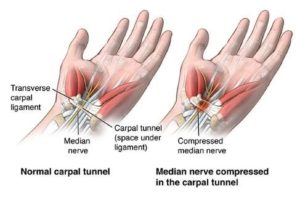 image (10)
image (10)
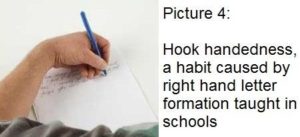
Left-handed students and their parents and/or teachers need not worry! There are many strategies to help alleviate left-handed obstacles. Teachers and parents can encourage a left-hand child to position their paper correctly. Below is a picture of correct left-handed paper position. This will help reduce hooking the wrist and promote a more efficient dragging versus pushing movement.
image (10)

Teaching left-handed children handwriting can also be made easier with Learning without Tears Handwriting Curriculum as they state “every workbook is lefty friendly. Teaching pages provide models on the left and right so that left-handed children can easily see the model they are copying. Lefties never have to lift their hands or place them in an awkward position to see a model” (see below)
image (13)

Other ways to help left-handed students with hand/finger position and paper position include angled writing implements such as these:

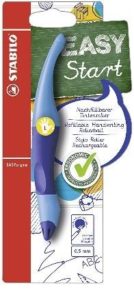

A person who is left-handed often finds spiral bound notepads uncomfortable as their hand rests on the metal coils. An easy way to avoid that is to use notepads that are stitched or glued, or that are spiral bound at the top.

Other tools that help left-handed children include a left-handed ruler for reversed graduation for natural right-to-left measuring;

and a pencil sharpener that reverses the direction to make it easier to sharpen pencils:

Of all the adaptations for left-handed children in school the most important one would be getting appropriate scissors. Whether scissors are right or left handed depends least on the handle of the scissors. Many scissors are touted as both right and left-handed because the handle is shaped in a manner that comfortably fits both the right or left hand. However, the most important factor is the position of the blades. On standard right scissors, the cutting edges are on the left side so that the cutting surface is visible. This blade configuration also causes the force of the scissors towards each other. When a left-handed person uses right hand scissors, it is difficult to see the cutting surface, so that the child ends up turning the scissors in a pronated position (thumbs down position). The force of a left hand on right hand blades also forces them apart instead of together, so that the cutting surface is not completely perpendicular to the paper. Therefore, the cut is not as precise. Left handed scissors have the blades reversed. The following are good scissors for left-handed children:
Pre-K to K (Blunt Tips)
These scissors are good for left-handed children who have not yet developed the coordination of opening and closing of the blades. The small lever pushes down to help blades open. As the child gains skill, it can be moved out of the way and used like standard scissors.
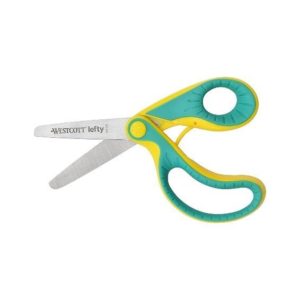
These scissors are still for beginning cutters, maintaining the blunt tips, but require the child to coordinate opening and closing blades.

Grade 1-3 (Pointed Tips)
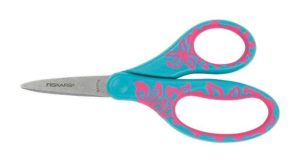
Youth Scissors (Grade 4-8)

Teenager and Adult-Size

This blog just touched on some of the variables associated with left-handedness. For more information about helping children or students who are left-handed, there are two great books available:
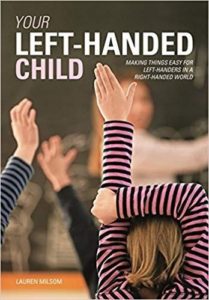
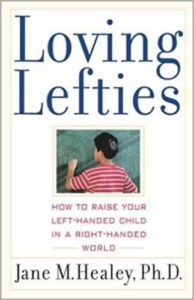
There is also a really cool club for left-handers that provides a lot of great information for individuals and parents:
http://www.lefthandersclub.org/
References:
- https://www.quora.com/Why-are-lefties-called-South-Paw
- https://www.livescience.com/19968-study-reveals-lefties-rare.html
- https://www.tripsavvy.com/indian-etiquette-donts-1539435
- https://crixeo.com/left-handed-people/
- http://www.rightleftrightwrong.com/brain.html
- http://www.intropsych.com/ch02-human-nervous-system/hemispheric-specialization.html
- http://brainblogger.com/2014/11/25/the-mystery-of-left-handedness/
- https://www.businessinsider.com/why-some-people-are-left-handed-2018-1
- https://api.kramesstaywell.com/Content/ebd5aa86-5c85-4a95-a92a-a524015ce556/medical-illustrations/Images/amuscsk20140312v0003.jpg
- http://intransitive101.blogspot.com/2017/08/left-handers-day-2017-part-2.html
- Milsom, Lauren, “Your Left-Handed Child. Making Things Easy for Left-Handers in a Right-Handed World”. 2008 London Octopus Publishing Group.
- Healey, Jane M., “Loving Lefties. How to Raise Your Left-Handed Child in A Right-Handed World” NY, NY 2001 LifeTime Media, Inc.
- https://www.lwtears.com/
- http://www.lefthandersclub.org
Disclaimer:
The information on this blog is meant to provide general information, should not be used as medical advice. If you need specific therapeutic advice, you should consult a therapist in person.
I share a lot of toy and product ideas, and I link to them on Amazon and other affiliates. I only reference products I know. Most of my links are affiliate or associate links, which means that I will get a few cents if you happen to buy the item while you are there. If you are going to purchase these items, please use my links to support my blog. Thanks!


